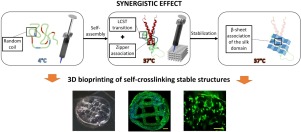Applied Materials Today ( IF 7.2 ) Pub Date : 2019-11-17 , DOI: 10.1016/j.apmt.2019.100500 Soraya Salinas-Fernández , Mercedes Santos , Matilde Alonso , Luis Quintanilla , Jose Carlos Rodríguez-Cabello

|
The versatility of 3D bioprinting techniques has demonstrated great potential for the development of artificial engineered tissues that more closely resemble native tissues. Despite this, challenges remain as regards the search for new bioinks that embrace all the complex parameters that this technique demands. In an attempt to develop such an advanced material, a novel smart material based on elastin-like recombinamers (ELRs) has been developed by molecularly programming its sequence to exhibit a sequential three-stage gelation process, thus providing printing attributes.
The thermoresponsive behavior of the ELR is exploited for the deposition of well-controlled fibres on a platform heated to 37 °C, and its recombinant nature ensures batch-to-batch reproducibility and its applicability to a desired target tissue by the introduction of selected bioactive amino-acid sequences into its molecular chain.
The biocompatible nature of the ELR enables the printing of loaded cells while providing a protective environment as part of the printing process. Thus, HFF-1 cells were found to be able to proliferate within the printed structures upon culture, displaying their natural morphology.
The results of this work highlight the applicability and novelty of the bioprinting of biomimetic ELR-based structures for advanced applications.
中文翻译:

基因工程弹性蛋白样重组子,具有基于序列的分子稳定性,可作为3D生物打印的高级生物墨水
3D生物打印技术的多功能性已显示出开发出与天然组织更相似的人工工程组织的巨大潜力。尽管如此,在寻找包含该技术所需的所有复杂参数的新生物墨水方面仍然存在挑战。为了开发这种先进的材料,已经通过分子编程其序列以显示出顺序的三阶段凝胶化过程,从而开发了基于弹性蛋白样重组子(ELR)的新型智能材料,从而提供了印刷属性。
ELR的热响应性能被用于在加热到37°C的平台上沉积良好控制的纤维,并且其重组性质可确保通过引入选定的生物活性物质确保批次间的可重复性及其对所需靶组织的适用性氨基酸序列进入其分子链。
ELR具有生物相容性,因此可以打印负载的细胞,同时在打印过程中提供保护性环境。因此,发现HFF-1细胞在培养后能够在印刷的结构内增殖,表现出它们的自然形态。
这项工作的结果突出了仿生基于ELR的结构的生物印刷在高级应用中的适用性和新颖性。











































 京公网安备 11010802027423号
京公网安备 11010802027423号